Helensburgh
Formed 1896. Wound up in 1928.
Founder member of Scottish Division Three 1923. Joined the Scottish Alliance after Division Three was abandoned in 1926.
Kit History
Helensburgh (1)
1874-1882
Club Wound Up
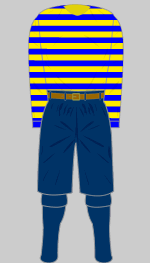
1874-1880 b e
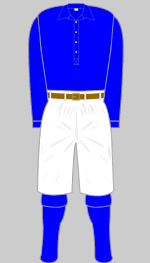
1880-1882 b
Helensburgh (2)
1885-1886
Club Wound Up
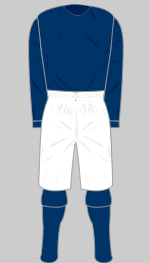
1885-1886 b c
Helensburgh (3)
1886
Club Wound Up

1886 b
Helensburgh (4)
1896-1928

1896-1907 c
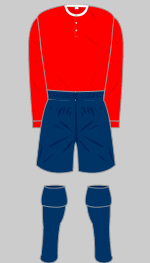
1907-1908 a
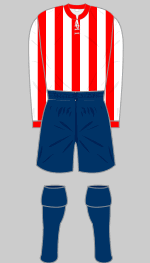
1910 a

1910-1921
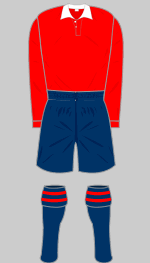
1921-1928 a d
Background
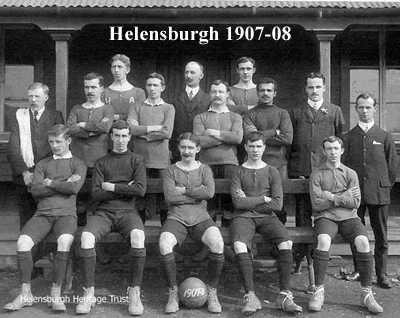 Situated on the northern
coast of the Firth of Clyde at the mouth of the Gareloch and a short
distance from Loch Lomond, Helensburgh is one of the more scenic areas
to have hosted senior football in Scotland, albeit briefly. There have been several
clubs called Helensburgh FC the first formed as far back as 1874 but
this club (who wore blue and yellow) was removed from the SFA register
in 1882 and presumably closed down. According to Brian McColl, two more
clubs rapidly came and went in 1885 and 1886 (the 1885 incarnation reaching
the semi-final of the Scottish FA Cup).
Situated on the northern
coast of the Firth of Clyde at the mouth of the Gareloch and a short
distance from Loch Lomond, Helensburgh is one of the more scenic areas
to have hosted senior football in Scotland, albeit briefly. There have been several
clubs called Helensburgh FC the first formed as far back as 1874 but
this club (who wore blue and yellow) was removed from the SFA register
in 1882 and presumably closed down. According to Brian McColl, two more
clubs rapidly came and went in 1885 and 1886 (the 1885 incarnation reaching
the semi-final of the Scottish FA Cup).
The fourth Helensburgh was formed in 1896 and were to remain a humble local side for many years. Although there is some doubt about where they played their early matches, Helensburgh were based for most of their existence at Ardencaple Park and it is now believed that the present Helensburgh RFC play on what used to be the football club's ground. Facilities were very basic, with some terracing and a small pavilion while the pitch was usually a quagmire.
Records of Helensburgh's colours are ambiguous. Norman Nicholl records them only as dark blue from 1896 until 1927. Alick Milne reports that according to SFA and SFL records, the team's registered colours were red shirts and blue knickers from 1921. Photographs collected by the Helensburgh Heritage Trust suggests red tops were adopted earlier but the evidence is not conclusive.
In 1910 Helensburgh reached the semi-finals of the Scottish Amateur Cup and in 1922, they joined the Western League and were runners-up in the Dunbartonshire Cup - they won this competition in 1925. In 1923 they were invited to join the new Scottish League Third Division. Although attendances at Ardencaple were generally in three figures, Helensburgh did attract a record 2,000 spectators to their ground for a Qualifying Cup tie against Royal Albert in September 1925.
The cost of providing match guarantees and high travel expenses proved too great a financial burden for the small clubs taking part in this ill-fated competition. In April 1926 the Helensburgh & Gareloch Times reported, "The affairs of the third division of the Scottish Football League appear to be in a serious condition. The long railway journeys to away games have killed this league. Mr FW McMillan (Helensburgh FC) called for a meeting of the teams to be held in Glasgow." An appeal to the Scottish League Management Committee was not sympathetically received and the division was wound up, its fixtures incomplete. Ironically Helensburgh were sitting at the top of the table, the only team to have fulfilled all their matches.
For the 1926-27 season, Helensburgh joined the Scottish Alliance. When they traveled to Pittodrie to play Aberdeen in a Scottish cup tie, 14,000 people came to watch, by far the biggest crowd the club ever played in front of. In 1927 Helensburgh became a junior club but even at this level they struggled and in 1928, they closed down.
This article draws heavily on Jim Chestnut's short history of the club, available from the Helensburgh Heritage Trust
Sources
- (a) Helensburgh Heritage Trust
- (b) Brian McColl
- (c) The Scottish League Former Members (Norman Nichol 1992)
- (d) Alick Milne
- (e) Charles Alcock's Football Annuals 1869-1891 researched by Robin Horton
Photograph courtesy of Helensburgh Heritage Trust Gallery